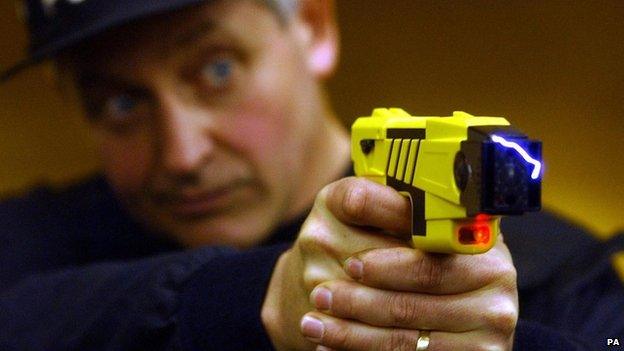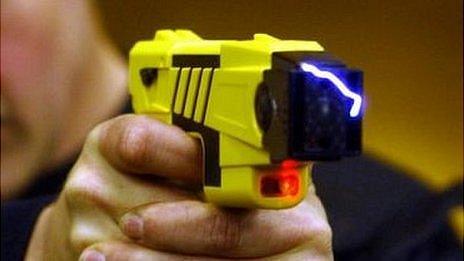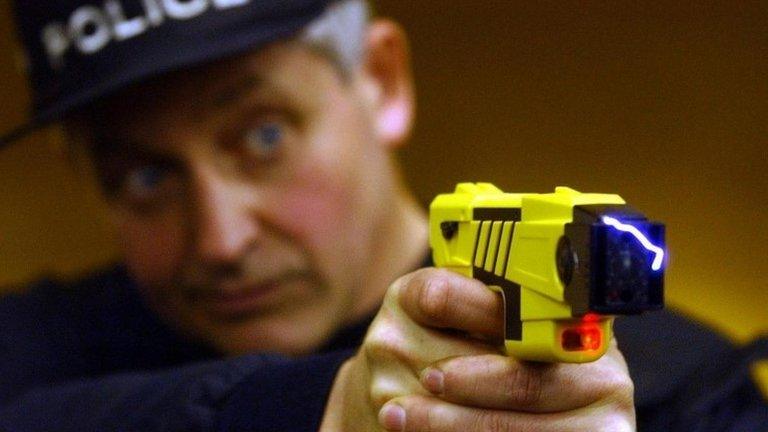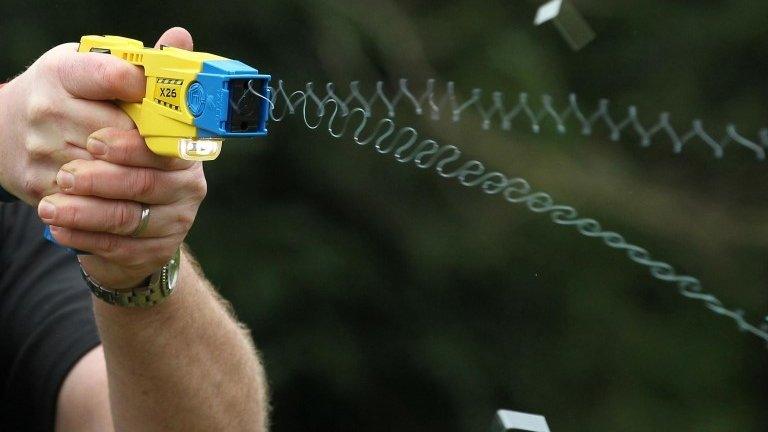Point-blank police Taser use questioned by IPCC
- Published
- comments

The IPCC raised concerns over the use of "drive stun" mode
The police watchdog has raised concerns over police officers in England and Wales using Tasers at point-blank range despite no longer being trained to do so.
The Independent Police Complaints Commission said the technique was "purely a means of pain compliance".
It also questioned why some smaller forces were more likely to use Tasers.
The Association of Chief Police Officers said point-blank firing was sometimes necessary.
Complaint rate
Tasers were introduced into British policing in 2003 as a non-lethal alternative for firearms officers facing potentially dangerous suspects.
Each force now has officers who can be authorised to use them in a wider range of situations.
While there had been high-profile instances of alleged abuse, the IPCC said, the rate of complaints remained low.
The watchdog said it acknowledged that the Taser was "a valuable tool" in helping police to manage difficult and challenging situations - but forces must do more to guard against its overuse.
But it warned that one technique, known as "drive stun" - where the Taser is held against the subject's body and the trigger pulled with no probes being fired, causing pain but not an incapacitating effect - was still being used in 16% of firings, despite officers no longer being trained to deploy the weapon in this fashion.
'Major concerns'
IPCC Commissioner James Dipple-Johnstone said: "The IPCC has major concerns about the use of Tasers in 'drive stun mode', where the Taser is applied directly to the body without a cartridge, rather than fired from a distance.
"When used in this way it is purely a means of pain compliance.
"Yet in several of the cases we reviewed, where it was used for the purpose of gaining compliance, it had the opposite effect, stimulating further resistance."

Acpo said there were circumstances where "drive stunning" might be necessary
While officers were not trained to use the drive stun option, they were still being shown that the option existed.
"This seems counter-intuitive if they are not supposed to be doing so," said the watchdog's report.
"There is a risk, given the increase in Taser use, that police officers could become increasingly reliant on using force to gain compliance.
"This is particularly apparent in drive-stun mode which generates a considerable number of complaints."
'Emergency circumstances'
Neil Basu from the Association of Chief Police Officers said: "The IPCC rightly identify that police do not teach the use of 'drive stun' with the cartridge off.
"However, it cannot be completely removed from training as there may be emergency circumstances where it is needed."
An example could be where an officer was attacked whilst reloading his, or her, weapon after an initial firing missed the intended target, he suggested.
He also said that "angled drive stun" - where the officer fires the weapon with a live cartridge installed, and then holds the Taser against a different part of the subject's body, to cause incapacitation, and which he called a "viable tactic" - may have been being confused with a "drive stun" and reported incorrectly.
"We anticipate that instances of drive stun will reduce significantly over the coming months and years."
Further investigation
In 2013, Tasers were deployed 10,380 times across England and Wales - and there were 154 complaints - a rate that has remained consistent over 10 years. In roughly eight out of 10 cases the Taser is not fired because a suspect complies with an order after seeing it unholstered. Fifteen of the complaints related to "drive stun" incidents.
The IPCC called on officers to do more to justify uses of the Taser against suspects already in custody or vulnerable people such as children or those with a mental disorder.
It said it also wanted to further investigate why some smaller forces were more likely to deploy the device than their larger neighbours.
Staffordshire Police used a Taser 33 times for every 100 officers in 2013 - almost three times the rate of use by West Midlands Police.
- Published22 July 2014

- Published8 April 2014

- Published16 April 2014

- Published16 April 2014
